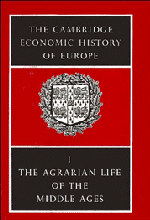Book contents
- Frontmatter
- Chapter I The Settlement and Colonization of Europe
- Chapter II Agriculture and Rural Life in the Later Roman Empire
- Chapter III The Evolution of Agricultural Technique
- Chapter IV Agrarian Institutions of the Germanic Kingdoms from the fifth to the ninth century
- Chapter V Agrarian conditions in the Byzantine Empire in the Middle Ages
- Chapter VI The Rise of Dependent Cultivation and Seignorial Institutions
- Chapter VII Medieval Agrarian Society in its Prime
- §1 France, The Low Countries, and Western Germany
- §2. Italy
- §3 Spain
- §4 The lands east of the Elbe and German colonization eastwards
- §5 Poland, Lithuania and Hungary
- §6 Russia
- §7 England
- §8 Scandinavia
- Chapter VIII Crisis: From the Middle Ages to Modern Times
- BIBLIOGRAPHIES
- Plate Section
- The Roman frontier and the Teutonic Tribes in the first and fourth centuries A.D.
- The Empire of Charles the Great
- Germany in the thirteenth century
- References
§8 - Scandinavia
from Chapter VII - Medieval Agrarian Society in its Prime
Published online by Cambridge University Press: 28 March 2008
- Frontmatter
- Chapter I The Settlement and Colonization of Europe
- Chapter II Agriculture and Rural Life in the Later Roman Empire
- Chapter III The Evolution of Agricultural Technique
- Chapter IV Agrarian Institutions of the Germanic Kingdoms from the fifth to the ninth century
- Chapter V Agrarian conditions in the Byzantine Empire in the Middle Ages
- Chapter VI The Rise of Dependent Cultivation and Seignorial Institutions
- Chapter VII Medieval Agrarian Society in its Prime
- §1 France, The Low Countries, and Western Germany
- §2. Italy
- §3 Spain
- §4 The lands east of the Elbe and German colonization eastwards
- §5 Poland, Lithuania and Hungary
- §6 Russia
- §7 England
- §8 Scandinavia
- Chapter VIII Crisis: From the Middle Ages to Modern Times
- BIBLIOGRAPHIES
- Plate Section
- The Roman frontier and the Teutonic Tribes in the first and fourth centuries A.D.
- The Empire of Charles the Great
- Germany in the thirteenth century
- References
Summary
The Scandinavian states, their geography
Shortly after the middle of the eleventh century the political map of Scandinavia took the form it retained in the main during the whole of the medieval period. Sweden owned the Baltic coast from a point at the present boundary between the provinces of Blekinge and Smaaland right up into the great forests of northern Norrland, the provinces of Vaesterbotten and Norrbotten, for long but sparsely inhabited. Finland also belonged to the Swedish sphere of interest, but here, as in Norrland, Swedish penetration was not accomplished until the final decades of the period now under review. The political centre of the Swedish kingdom was the country round the Maelare, west of Stockholm, but agriculturally the large, interior plains of Oestergoetland and Vaestergoedand were most important. Only at a single point, the mouth of the river Goeta, did Sweden send a narrow wedge down to the West Coast.
Sweden faced the Baltic; Norway the Skagerrak, the North Sea and the Atlantic. The Norwegian settlements stretched from the river Goeta in the south via Troendelag round Trondheim up to Haalogaland on the Arctic Circle. They were usually of rather small extent, but particularly in Troendelag, round the Oslo Fiord and in certain river valleys they stretched far up-country. Nevertheless, the interior of Norway was for the most part unsuitable for permanent settlement, though there were settlements that did not link up with the coast, such as Jaemdand, which, whether it originally belonged to Sweden or not, was included in Norway during our period.
Keywords
- Type
- Chapter
- Information
- Publisher: Cambridge University PressPrint publication year: 1966

